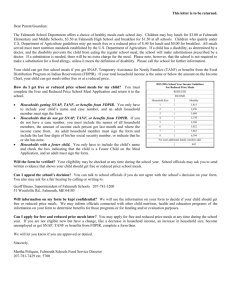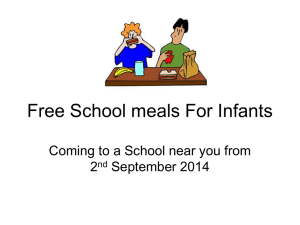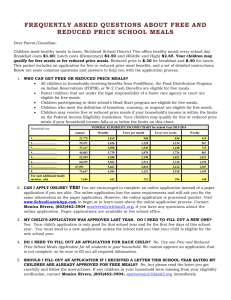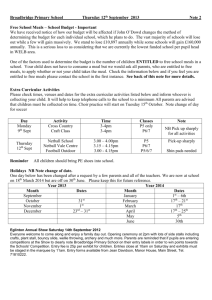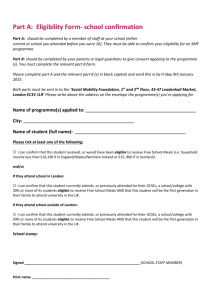wappingers central school district food service department
advertisement
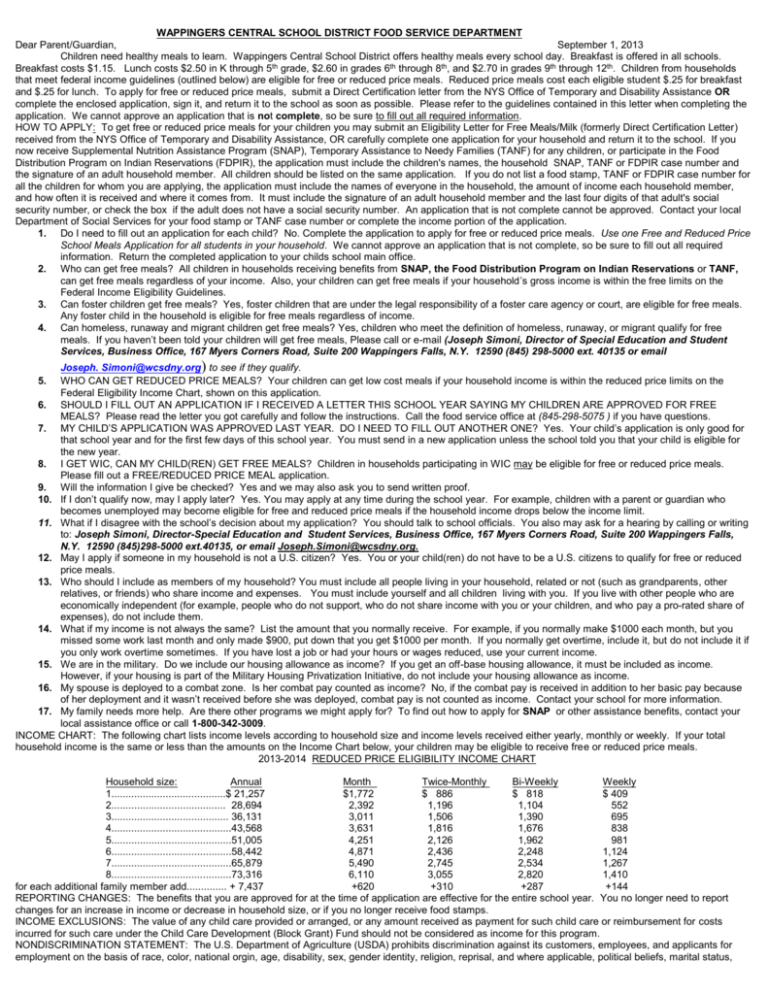
WAPPINGERS CENTRAL SCHOOL DISTRICT FOOD SERVICE DEPARTMENT Dear Parent/Guardian, September 1, 2013 Children need healthy meals to learn. Wappingers Central School District offers healthy meals every school day. Breakfast is offered in all schools. Breakfast costs $1.15. Lunch costs $2.50 in K through 5th grade, $2.60 in grades 6th through 8th, and $2.70 in grades 9th through 12th. Children from households that meet federal income guidelines (outlined below) are eligible for free or reduced price meals. Reduced price meals cost each eligible student $.25 for breakfast and $.25 for lunch. To apply for free or reduced price meals, submit a Direct Certification letter from the NYS Office of Temporary and Disability Assistance OR complete the enclosed application, sign it, and return it to the school as soon as possible. Please refer to the guidelines contained in this letter when completing the application. We cannot approve an application that is not complete, so be sure to fill out all required information. HOW TO APPLY: To get free or reduced price meals for your children you may submit an Eligibility Letter for Free Meals/Milk (formerly Direct Certification Letter) received from the NYS Office of Temporary and Disability Assistance, OR carefully complete one application for your household and return it to the school. If you now receive Supplemental Nutrition Assistance Program (SNAP), Temporary Assistance to Needy Families (TANF) for any children, or participate in the Food Distribution Program on Indian Reservations (FDPIR), the application must include the children's names, the household SNAP, TANF or FDPIR case number and the signature of an adult household member. All children should be listed on the same application. If you do not list a food stamp, TANF or FDPIR case number for all the children for whom you are applying, the application must include the names of everyone in the household, the amount of income each household member, and how often it is received and where it comes from. It must include the signature of an adult household member and the last four digits of that adult's social security number, or check the box if the adult does not have a social security number. An application that is not complete cannot be approved. Contact your local Department of Social Services for your food stamp or TANF case number or complete the income portion of the application. 1. Do I need to fill out an application for each child? No. Complete the application to apply for free or reduced price meals. Use one Free and Reduced Price School Meals Application for all students in your household. We cannot approve an application that is not complete, so be sure to fill out all required information. Return the completed application to your childs school main office. 2. Who can get free meals? All children in households receiving benefits from SNAP, the Food Distribution Program on Indian Reservations or TANF, can get free meals regardless of your income. Also, your children can get free meals if your household’s gross income is within the free limits on the Federal Income Eligibility Guidelines. 3. Can foster children get free meals? Yes, foster children that are under the legal responsibility of a foster care agency or court, are eligible for free meals. Any foster child in the household is eligible for free meals regardless of income. 4. Can homeless, runaway and migrant children get free meals? Yes, children who meet the definition of homeless, runaway, or migrant qualify for free meals. If you haven’t been told your children will get free meals, Please call or e-mail (Joseph Simoni, Director of Special Education and Student Services, Business Office, 167 Myers Corners Road, Suite 200 Wappingers Falls, N.Y. 12590 (845) 298-5000 ext. 40135 or email Joseph. Simoni@wcsdny.org) to see if they qualify. WHO CAN GET REDUCED PRICE MEALS? Your children can get low cost meals if your household income is within the reduced price limits on the Federal Eligibility Income Chart, shown on this application. 6. SHOULD I FILL OUT AN APPLICATION IF I RECEIVED A LETTER THIS SCHOOL YEAR SAYING MY CHILDREN ARE APPROVED FOR FREE MEALS? Please read the letter you got carefully and follow the instructions. Call the food service office at (845-298-5075 ) if you have questions. 7. MY CHILD’S APPLICATION WAS APPROVED LAST YEAR. DO I NEED TO FILL OUT ANOTHER ONE? Yes. Your child’s application is only good for that school year and for the first few days of this school year. You must send in a new application unless the school told you that your child is eligible for the new year. 8. I GET WIC, CAN MY CHILD(REN) GET FREE MEALS? Children in households participating in WIC may be eligible for free or reduced price meals. Please fill out a FREE/REDUCED PRICE MEAL application. 9. Will the information I give be checked? Yes and we may also ask you to send written proof. 10. If I don’t qualify now, may I apply later? Yes. You may apply at any time during the school year. For example, children with a parent or guardian who becomes unemployed may become eligible for free and reduced price meals if the household income drops below the income limit. 11. What if I disagree with the school’s decision about my application? You should talk to school officials. You also may ask for a hearing by calling or writing to: Joseph Simoni, Director-Special Education and Student Services, Business Office, 167 Myers Corners Road, Suite 200 Wappingers Falls, N.Y. 12590 (845)298-5000 ext.40135, or email Joseph.Simoni@wcsdny.org. 12. May I apply if someone in my household is not a U.S. citizen? Yes. You or your child(ren) do not have to be a U.S. citizens to qualify for free or reduced price meals. 13. Who should I include as members of my household? You must include all people living in your household, related or not (such as grandparents, other relatives, or friends) who share income and expenses. You must include yourself and all children living with you. If you live with other people who are economically independent (for example, people who do not support, who do not share income with you or your children, and who pay a pro-rated share of expenses), do not include them. 14. What if my income is not always the same? List the amount that you normally receive. For example, if you normally make $1000 each month, but you missed some work last month and only made $900, put down that you get $1000 per month. If you normally get overtime, include it, but do not include it if you only work overtime sometimes. If you have lost a job or had your hours or wages reduced, use your current income. 15. We are in the military. Do we include our housing allowance as income? If you get an off-base housing allowance, it must be included as income. However, if your housing is part of the Military Housing Privatization Initiative, do not include your housing allowance as income. 16. My spouse is deployed to a combat zone. Is her combat pay counted as income? No, if the combat pay is received in addition to her basic pay because of her deployment and it wasn’t received before she was deployed, combat pay is not counted as income. Contact your school for more information. 17. My family needs more help. Are there other programs we might apply for? To find out how to apply for SNAP or other assistance benefits, contact your local assistance office or call 1-800-342-3009. INCOME CHART: The following chart lists income levels according to household size and income levels received either yearly, monthly or weekly. If your total household income is the same or less than the amounts on the Income Chart below, your children may be eligible to receive free or reduced price meals. 2013-2014 REDUCED PRICE ELIGIBILITY INCOME CHART 5. Household size: Annual Month Twice-Monthly Bi-Weekly Weekly 1........................................$ 21,257 $1,772 $ 886 $ 818 $ 409 2........................................ 28,694 2,392 1,196 1,104 552 3......................................... 36,131 3,011 1,506 1,390 695 4..........................................43,568 3,631 1,816 1,676 838 5..........................................51,005 4,251 2,126 1,962 981 6..........................................58,442 4,871 2,436 2,248 1,124 7..........................................65,879 5,490 2,745 2,534 1,267 8..........................................73,316 6,110 3,055 2,820 1,410 for each additional family member add.............. + 7,437 +620 +310 +287 +144 REPORTING CHANGES: The benefits that you are approved for at the time of application are effective for the entire school year. You no longer need to report changes for an increase in income or decrease in household size, or if you no longer receive food stamps. INCOME EXCLUSIONS: The value of any child care provided or arranged, or any amount received as payment for such child care or reimbursement for costs incurred for such care under the Child Care Development (Block Grant) Fund should not be considered as income for this program. NONDISCRIMINATION STATEMENT: The U.S. Department of Agriculture (USDA) prohibits discrimination against its customers, employees, and applicants for employment on the basis of race, color, national orgin, age, disability, sex, gender identity, religion, reprisal, and where applicable, political beliefs, marital status, familial or parental status, sexual orientation, or all or part of an individual’s income is derived from any public assistance program, or protected genetic information in employment or in any program or activity conducted or funded by the Department. (Not all prohibited basis will apply to all programs and/or employement activities.) If you wish to file a Civil Rights program complaint of discrimination, complete the USDA Program Discrimination Complaint Form (PDF), found online at http://..www.ascr.usda.gov/complaint_filing_cust.html, or at any USDA office, or call (866) 632-9992 to request the form. You may also write a letter containing all of the information requested in the form. Send your completed complaint from or letter to us by mail at U.S. Department of Agriculture, Director, Office of Adjudication, 1400 Independence Avenue, S.W., Washington D.C. 20250-9410, by fax (202) 690-7442 or email at program.intake@usda.gov. Individuals who are deaf, hard of hearing, or have speech disabilities and wish to file either an EEO or program complaint please contact USDA through the Federal Relay Service at (800) 877-8339 or (800) 845-6136. USDA is an equal opportunity provider and employer. MEAL SERVICE TO CHILDREN WITH DISABILITIES: Federal regulations require schools and institutions to serve meals at no extra charge to children with a disability which may restrict their diet. A student with a disability is defined in 7CFR Part 15b.3 of Federal regulations, as one who has a physical or mental impairment which substantially limits one or more major life activities. Major life activities are defined to include functions such as caring for one's self, performing manual tasks, walking, seeing, hearing, speaking, breathing, learning, and working. You must request the special meals from the school and provide the school with medical certification from a medical doctor. If you believe your child needs substitutions because of a disability, please get in touch with us for further information, as there is specific information that the medical certification must contain. STUDENT MEAL ACCOUNT 5670 Charging meals is a courtesy extended to the student and should not occur on a regular basis. It is the policy of the Wappingers Central School District to allow students in grades K-8 to charge meals on an occasion when money is unavailable and the student would have to miss meal service. Students at the high schools are not allowed to charge meals at all. Only meals may be charged, not a la carte. Students in grades K-3 may charge no more than five meals. Students in grades 4-8 may charge no more than three meals. Any student denied the ability to charge a regular meal will be provided, at no cost, a choice of available sandwiches with the side dishes needed to provide a nutritionally balanced meal. Students who are denied meals will be referred to the administration and their parents will be encouraged to apply for free or reduced priced meals. Students in grades K-8 will be provided with one written warning before they are denied charges. CONFIDENTIALITY: The United States Department of Agriculture has approved the release of students names and eligibility status, without parent/guardian consent, to persons directly connected with the administration or enforcement of federal education programs such as Title I and the National Assessment of Educational Progress (NAEP), which are United States Department of Education programs used to determine areas such as the allocation of funds to schools, to evaluate socioeconomic status of the school's attendance area, and to assess educational progress. Information may also be released to State health or State education programs administered by the State agency or local education agency, provided the State or local education agency administers the program, and federal State or local nutrition programs similar to the National School Lunch Program. Additionally, all information contained in the free and reduced price application may be released to persons directly connected with the administration or enforcement of programs authorized under the National School Lunch Act (NSLA) or Child Nutrition Act (CNA); including the National School Lunch and School Breakfast Programs, the Special Milk Program, the Child and Adult Care Food Program, Summer Food Service Program and the Special Supplemental Nutrition Program for Women Infants and Children (WIC); the Comptroller General of the United States for audit purposes, and federal, State or local law enforcement officials investigating alleged violation of the programs under the NSLA or CNA. The disclosure of eligibility information not specifically authorized by the NSLA requires a written consent statement from the parent/guardian. We will let you know when your application is approved or denied. Sincerely, Abraham Nuchman, Food Service Director FACT SHEET: When filling out the application form, please pay careful attention to these helpful hints. SNAP/TANF/FDPIR case number: This must be the complete case number supplied to you by the agency including all numbers and letters, for example, E 123456, or whatever combination is used in your county. Refer to a letter you received from your local Department of Social Services for your case number or contact them for your number. All children with the same case number may be listed on the same application. If anyone in your household receives SNAP, all children living in your household are eligible to receive free meals at school. DIRECT CERTIFICATION: Your children’s school may have already certified your child to receive meals at no charge. If your child has not already been certified and you receive SNAP or TANF, send in the Eligibility Letter from the NYS Office of Temporary and Disability Assistance instead of completing the application. Make a copy for your records. FOSTER CHILD: A child who is living with a family but who is under the legal care of the welfare agency or court may be listed on your family application. List the child’s “personal use” income. This includes only those funds provided by the agency which are identified for the personal use of the child, such as personal spending allowances, money received by his/her family, or from a job. Funds provided for housing, food and care, medical, and therapeutic needs are not considered income to the foster child. Write ”0” if the child has no personal use income. HOUSEHOLD:A group of related or non-related people who are living in one house and share income and expenses. ADULT FAMILY MEMBERS: All related and non-related people who are 21 years of age and older living in your house. FINANCIALLY INDEPENDENT: A person is financially independent and a separate economic unit/household when his or her earnings and expenses are not shared by the family/household. GROSS INCOME: Is money earned or received by each member of your household before deductions. Examples of deductions are Federal tax, State tax, and Social Security deductions. Examples of gross income are: *Wages, salaries, tips, commissions, or income from self-employment *Net farm income – gross sales minus expenses only – not losses *Pensions, annuities, or other retirement income including Social Security retirement benefits *Unemployment compensation *Welfare payments (does not include value of SNAP) *Public Assistance payments *Adoption assistance *Strike benefits *Supplemental Security Income (SSI) or Social Security Survivor’s Benefits *Alimony or child support payments *Disability benefits, including workman’s compensation *Veteran’s subsistence benefits *Interest or dividend income *Cash withdrawn from savings, investments, trusts, and other resources which would be available to pay for a child’s meals *Other cash income If you have more than one job, you must list the income from all jobs. If you receive income from more than one source (wage, alimony, child support, etc.), you must list the income from all sources. CURRENT INCOME: Your income at the present time before deductions. Only farmers, self-employed workers, migrant workers, and other seasonal employees may use their income for the past 12 months reported from their 1040 Tax Forms. INCOME EXCLUSIONS:The value of any child care provided or arranged, or any amount received as payment for such child care or reimbursement for costs incurred for such care under the Child Care Development (Block Grant) Fund should not be considered as income for this program. If you have any questions or need help in filling out the application form, please contact: Abraham Nuchman, Food Service Director 845-298-5075


